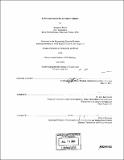IT management in the aerospace industry
Author(s)
Ferre, Gregoire, 1978-
DownloadFull printable version (5.759Mb)
Alternative title
Information technology management in the aerospace industry
Other Contributors
Massachusetts Institute of Technology. Technology and Policy Program.
Advisor
Eric Rebentisch.
Terms of use
Metadata
Show full item recordAbstract
(cont.) payoff IT investments. When the North American Aerospace Industry invests less than any other industry in the high risk investments, its foreign counterpart invests more than any other industry. The second major finding is that the governance mechanisms in place are similar in the two Aerospace Industry segments, contrary to the IT Portfolios. IT decisions are made usually by IT executives or business executives, based on the information provided by Chief level executives and at least one other business group. Finally, the third major finding is that the Aerospace Industry gets above average returns from IT by being good at IT Business Planning, Top Management involvement and User Satisfaction. However, a major effort needs to be placed on improving user satisfaction as it is not always properly managed and hinders returns from IT. The lack of extensive communication also hinders the returns from IT by not guarantying top management involvement and awareness of the IT governance mechanisms. This thesis originated by a need for the Lean Aerospace Industry to study in the Aerospace Industry what seems to be a troublesome domain for many other industries: Information Technologies (IT). Beforehand, there were two ways to do so: study how aerospace companies implement major systems like Enterprise Resource Planning (ERP) or Product Data Management (PDM). After a few short case studies, it seemed companies were puzzled by the true extent and the pervasiveness of IT. Therefore, we chose to not look at IT "locally" but try to understand the bigger picture. This thesis is largely based on the pioneering work done by Peter Weill and the Center for Information Systems Research of the MIT Sloan School of Management on IT Portfolio and IT governance. It rationalizes IT by setting it as a portfolio, just like financial investments. Balancing the IT portfolio will ensure anticipated alignment with the corporate strategies. However, the elaboration of proper IT governance mechanisms is necessary to ensure value and return from IT. Defining the governance is "specifying the decision rights and accountability framework to encourage desirable behavior on the use of IT". We therefore applied the IT Portfolio and IT governance frameworks defined by Peter Weill to the Aerospace Industry through the analysis of surveys available in Appendix D. We were able to get data from ten different companies spread out across the world. This allowed us to examine several IT profiles, and to make several significant findings, among which three are of major importance and are described below. The first major finding is that the North American IT portfolio is risk-averse, while the aggregated rest of the world is prone to invest heavily in high risk/high
Description
Thesis (S.M.)--Massachusetts Institute of Technology, Engineering Systems Division, Technology and Policy Program, 2004. Leaf 95 blank. Includes bibliographical references (leaf 68).
Date issued
2004Department
Massachusetts Institute of Technology. Engineering Systems Division; Technology and Policy ProgramPublisher
Massachusetts Institute of Technology
Keywords
Technology and Policy Program.